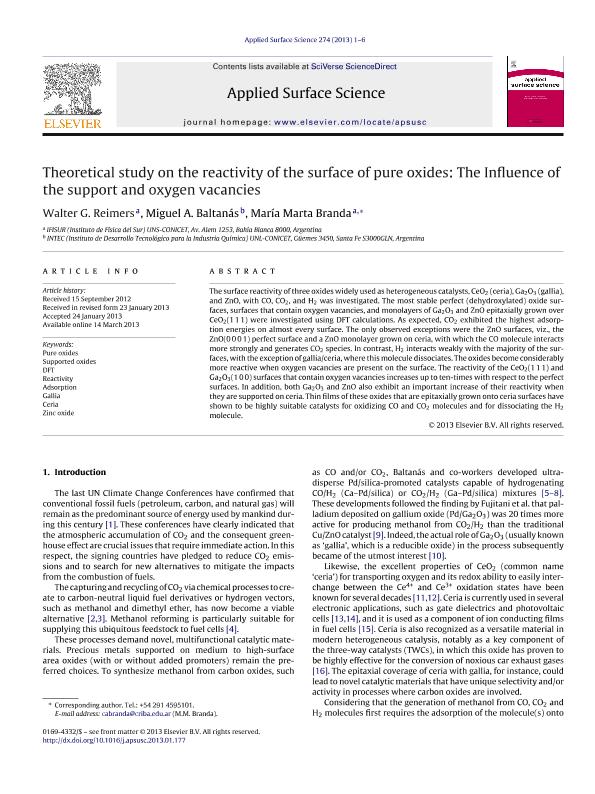Mostrar el registro sencillo del ítem
dc.contributor.author
Reimers, Walter Guillermo

dc.contributor.author
Baltanás, Miguel Angel

dc.contributor.author
Branda, María Marta

dc.date.available
2015-09-23T18:20:50Z
dc.date.issued
2013-06-01
dc.identifier.citation
Reimers, Walter Guillermo; Baltanás, Miguel Angel; Branda, María Marta; Theoretical study on the reactivity of the surface of pure oxides: The Influence of the support and oxygen vacancies; Elsevier Science; Applied Surface Science; 274; 1-6-2013; 1-6
dc.identifier.issn
0169-4332
dc.identifier.uri
http://hdl.handle.net/11336/2069
dc.description.abstract
The surface reactivity of three oxides widely used as heterogeneous catalysts, CeO2 (ceria), Ga2O3 (gallia), and ZnO, with CO, CO2, and H2 was investigated. The most stable perfect (dehydroxylated) oxide surfaces, surfaces that contain oxygen vacancies, and monolayers of Ga2O3 and ZnO epitaxially grown over CeO2(1 1 1) were investigated using DFT calculations. As expected, CO2 exhibited the highest adsorption energies on almost every surface. The only observed exceptions were the ZnO surfaces, viz., the ZnO(0 0 0 1) perfect surface and a ZnO monolayer grown on ceria, with which the CO molecule interacts more strongly and generates CO2 species. In contrast, H2 interacts weakly with the majority of the surfaces, with the exception of gallia/ceria, where this molecule dissociates. The oxides become considerably more reactive when oxygen vacancies are present on the surface. The reactivity of the CeO2(1 1 1) and Ga2O3(1 0 0) surfaces that contain oxygen vacancies increases up to ten-times with respect to the perfect surfaces. In addition, both Ga2O3 and ZnO also exhibit an important increase of their reactivity when they are supported on ceria. Thin films of these oxides that are epitaxially grown onto ceria surfaces have shown to be highly suitable catalysts for oxidizing CO and CO2 molecules and for dissociating the H2 molecule.
dc.format
application/pdf
dc.language.iso
eng
dc.publisher
Elsevier Science

dc.rights
info:eu-repo/semantics/openAccess
dc.rights.uri
https://creativecommons.org/licenses/by-nc-nd/2.5/ar/
dc.subject
ADSORPTION
dc.subject
CERIA
dc.subject
DFT
dc.subject
GALLIA
dc.subject
PURE OXIDES
dc.subject
REACTIVITY
dc.subject
SUPPORTED OXIDES
dc.subject
ZINC OXIDE
dc.subject.classification
Físico-Química, Ciencia de los Polímeros, Electroquímica

dc.subject.classification
Ciencias Químicas

dc.subject.classification
CIENCIAS NATURALES Y EXACTAS

dc.title
Theoretical study on the reactivity of the surface of pure oxides: The Influence of the support and oxygen vacancies
dc.type
info:eu-repo/semantics/article
dc.type
info:ar-repo/semantics/artículo
dc.type
info:eu-repo/semantics/publishedVersion
dc.date.updated
2016-03-30 10:35:44.97925-03
dc.journal.volume
274
dc.journal.pagination
1-6
dc.journal.pais
Países Bajos

dc.journal.ciudad
Amsterdam
dc.description.fil
Fil: Reimers, Walter Guillermo. Consejo Nacional de Investigaciones Científicas y Técnicas. Centro Científico Tecnológico Conicet - Bahía Blanca. Instituto de Física del Sur. Universidad Nacional del Sur. Departamento de Física. Instituto de Física del Sur; Argentina
dc.description.fil
Fil: Baltanás, Miguel Angel. Consejo Nacional de Investigaciones Científicas y Técnicas. Centro Científico Tecnológico Conicet - Santa Fe. Instituto de Desarrollo Tecnológico para la Industria Química. Universidad Nacional del Litoral. Instituto de Desarrollo Tecnológico para la Industria Química; Argentina
dc.description.fil
Fil: Branda, María Marta. Consejo Nacional de Investigaciones Científicas y Técnicas. Centro Científico Tecnológico Conicet - Bahía Blanca. Instituto de Física del Sur. Universidad Nacional del Sur. Departamento de Física. Instituto de Física del Sur; Argentina
dc.journal.title
Applied Surface Science

dc.relation.alternativeid
info:eu-repo/semantics/altIdentifier/url/http://www.sciencedirect.com/science/article/pii/S0169433213002468
dc.relation.alternativeid
info:eu-repo/semantics/altIdentifier/doi/http://dx.doi.org/10.1016/j.apsusc.2013.01.177
Archivos asociados
